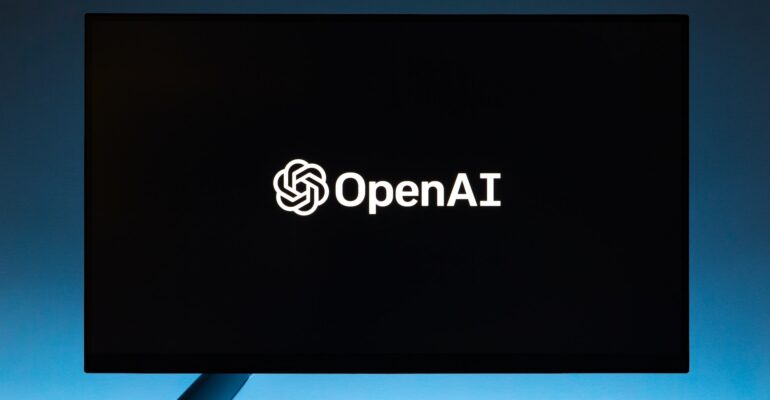How Microsoft intervened to get Altman back at OpenAI
Welcome to the forty-third edition of ‘3-2-1 by Story Rules‘.
A newsletter recommending good examples of storytelling across:
- 3 tweets
- 2 articles, and
- 1 long-form content piece
Let’s dive in.
🐦 3 Tweets of the week

You could say that Earth has 1.38 billion sq km of water…
… or just show the above striking visual.
Read this source article to view a higher-resolution image and to know more about this striking data point.
PS: The Epic Maps Twitter handle should have given credit to the creators of this map – Howard Perlman of USGS, Jack Cook of Woods Hole Oceanographic Institution, and Adam Nieman.

It would be so cool to stand here and cross over from ‘America’ to ‘Europe’ in one giant leap!

Just two words. And a picture that’s worth a thousand more. Also, great use of hyperbole.
📄 2 Articles of the week
a. 3 dead-simple steps to edit your writing in 10 minutes or less by Dickie Bush
Dickie shares some useful advice on how to edit your writing better.
It may not be possible to do it in just 10 mins (that was needless clickbait)… but the tips are useful.

On #3 above: For this newsletter, I write it on a laptop, but for editing, I always read it on my phone!
b. How raw materials shape global politics by Caitlin Allen (reviewing Ed Conway’s book)
This is a great WW-2 story:
The year is 1915, war is raging on the Western Front and a spy has been despatched from London to Switzerland to hatch a secret deal with the enemy.
The spy-in-question has been sent to procure a vital weapon of war: optical glass.
…
At the time, Britain had the misfortune of relying heavily on Germany for this vital material which led to an extraordinary attempt to buy glass off the enemy. In order to defeat the enemy… Even more amazingly, the Germans agreed. Because, as Conway explains, they were in desperate need of rubber – of which Britain controlled much of the global supply via the colonies – so the warring countries decided to hatch a deal.This overlooked historical episode sheds light on the way in which geology and the struggle to procure raw materials shape global politics. This is the overarching theme of Conway’s book.
And it has present-day implications:
“The material world is something that China has been thinking about for some time – a lot longer than the US and UK.” And with the green energy transition afoot, this disparity is set to become ever more troubling. When it comes to its net zero ambitions, the UK – like much of the world – is heavily dependent on Beijing for raw materials, especially batteries for electric vehicles. “Particularly with LFB batteries, which are the most important ones, China completely dominates the market,” says Conway.
📄 1 long-form read of the week
a. The Inside Story of Microsoft’s Partnership with OpenAI by Charles Duhigg
A fascinating long-read about the OpenAI CEO removal-and-reinstatement saga, told primarily from Microsoft’s point of view.
The story shares how Microsoft saw the massive potential for improving its own products using OpenAI’s work:
Microsoft hadn’t been at the forefront of the technology industry in years, but its alliance with OpenAI—which had originated as a nonprofit, in 2015, but added a for-profit arm four years later—had allowed the computer giant to leap over such rivals as Google and Amazon. The Copilots let users pose questions to software as easily as they might to a colleague—“Tell me the pros and cons of each plan described on that video call,” or “What’s the most profitable product in these twenty spreadsheets?”—and get instant answers, in fluid English. The Copilots could write entire documents based on a simple instruction. (“Look at our past ten executive summaries and create a financial narrative of the past decade.”) They could turn a memo into a PowerPoint. They could listen in on a Teams video conference, then summarize what was said, in multiple languages, and compile to-do lists for attendees.
…and learnt from its earlier missteps in incorporating it:
As Microsoft’s engineers designed how these Copilots would look and operate, they remembered the lessons of Clippy and Tay. The first conclusion from these fiascos was that it was essential to avoid anthropomorphizing A.I. Those earlier bots had failed, in part, because when they made mistakes they came across as stupid or malicious rather than as imperfect tools. For the Office Copilots, designers reminded users that they were interacting with a machine, not a person. There would be no googly eyes or perky names. Any Microsoft icon associated with a Copilot would consist of abstract shapes. The user interface would underscore A.I.’s propensity for missteps, by issuing warning messages and by advising users to scrutinize its outputs. Jaime Teevan, Microsoft’s chief scientist, helped oversee the Copilots’ development, and she told me that this approach “actually makes using the technology better,” adding, “Anthropomorphization limits our imagination. But if we’re pushed to think of this as a machine then it creates this blank slate in our minds, and we learn how to really use it.”
I found the above portion surprising. Generally, anthropomorphization works for me. But every tool is context-dependent and has its limitations.
Incidentally, the story does a great job of humanising a mega-corporation like Microsoft – by sharing personal anecdotes and stories of its leaders. Here’s the author on Kevin Scott, Microsoft’s CTO:
Kevin Scott’s certainty that A.I. could change the world was rooted in how thoroughly technology had reshaped his own life. He’d grown up in Gladys, Virginia, a small community not far from where Lee surrendered to Grant. Nobody in his family had ever gone to college, and health insurance was nearly a foreign concept. As a boy, Scott sometimes relied on neighbors for food. His father, a Vietnam vet who unsuccessfully tried to run a gas station, a convenience store, a trucking company, and various construction businesses, declared bankruptcy twice.
Scott wanted a different life. His parents bought him a set of encyclopedias on a monthly installment plan, and Scott—like a large language model avant la lettre – read them from A to Z. For fun, he took apart toasters and blenders. He saved enough money to afford Radio Shack’s cheapest computer, which he learned to program by consulting library books.
I’m sure – after reading just those two paras – you just found Mr. Scott much more relatable and worth rooting for right? That’s the CTO of a $200B company by the way.
And here’s an anecdote on Microsoft CEO, Satya Nadella:
Plan A was clearly a failure. So Microsoft’s executives switched to Plan B: Nadella began conferring with Murati to see if there was a way to reinstate Altman as C.E.O. Amid these conversations, the Cricket World Cup was occurring, and Nadella—a fan of India’s team, which was in the finals against Australia’s—occasionally broke the tension with updates on Virat Kohli’s performance at the wickets. (Many of Nadella’s colleagues had no idea what he was talking about.)
Aww – an Indian-American CEO following a cricket match while working on a major workplace crisis… that’s cute!
And to cover the OpenAI angle, here’s the writer on its CTO, Mira Murati:
Nadella and Scott’s confidence in this investment was buoyed by the bonds they’d formed with Altman, Sutskever, and OpenAI’s chief technology officer, Mira Murati. Scott particularly valued the connection with Murati. Like him, she had grown up poor. Born in Albania in 1988, she’d contended with the aftermath of a despotic regime, the rise of gangster capitalism, and the onset of civil war. She’d handled this upheaval by participating in math competitions. A teacher once told her that, as long as Murati was willing to navigate around bomb craters to make it to school, the teacher would do the same.
When Murati was sixteen, she won a scholarship to a private school in Canada, where she excelled. “A lot of my childhood had been sirens and people getting shot and other terrifying things,” she told me over the summer. “But there were still birthdays, crushes, and homework. That teaches you a sort of tenacity—to believe that things will get better if you keep working at them.”
Overall, Duhigg paints a picture where Microsoft comes across as a highly capable giant yet one with its heart in the right place. Duhigg is a feted author (Pulitzer-winning journalist, author of NYT bestsellers like ‘The Power of Habit’ and ‘Smarter, Faster, Better’), so he’s got the credibility. Still, the piece comes across as one with the blessings of Microsoft’s PR team!
That’s all from this week’s edition.
Photo by Andrew Neel on Unsplash







